Working and Leading with People: Recruitment, Leadership, and Teamwork
VerifiedAdded on 2020/06/06
|17
|4466
|142
Report
AI Summary
This report analyzes the leadership and management practices within Morrisons, a major UK supermarket chain. It begins by outlining the documentation required for recruiting a sales manager, considering legal, regulatory, and ethical factors, and describing the selection process. The report then delves into the skills and attributes of effective managers and leaders, differentiating between leadership and management skills, and comparing leadership theories in different situations. Furthermore, it explores two motivational theories (Maslow's and Herzberg's) to encourage staff. The report also discusses the benefits of teamwork, conflict resolution strategies, and methods to improve team effectiveness. Finally, it covers factors involved in planning, monitoring, and assessing employee development needs. The report provides a comprehensive overview of leadership and management principles, offering practical insights into their application within a real-world business context.
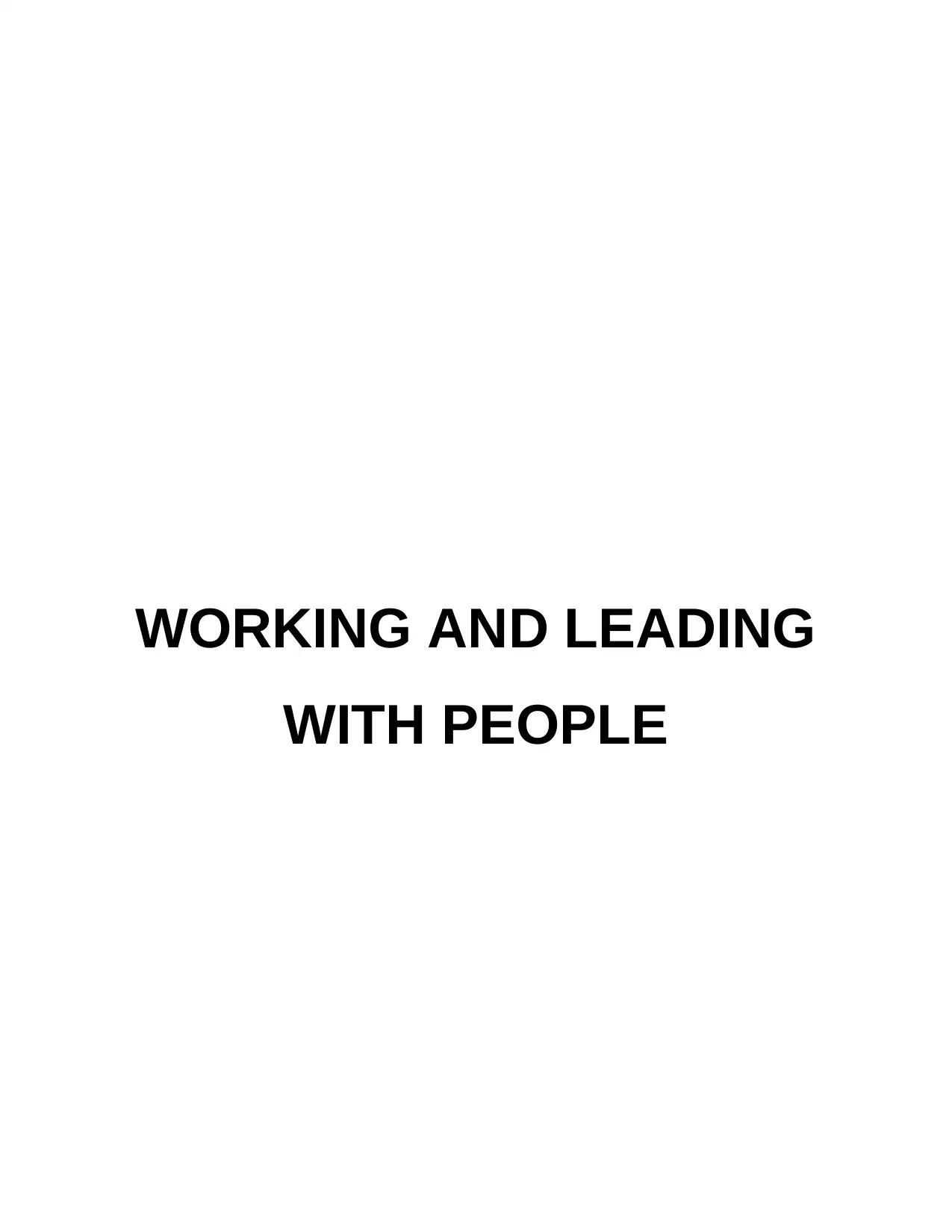
WORKING AND LEADING
WITH PEOPLE
WITH PEOPLE
Paraphrase This Document
Need a fresh take? Get an instant paraphrase of this document with our AI Paraphraser
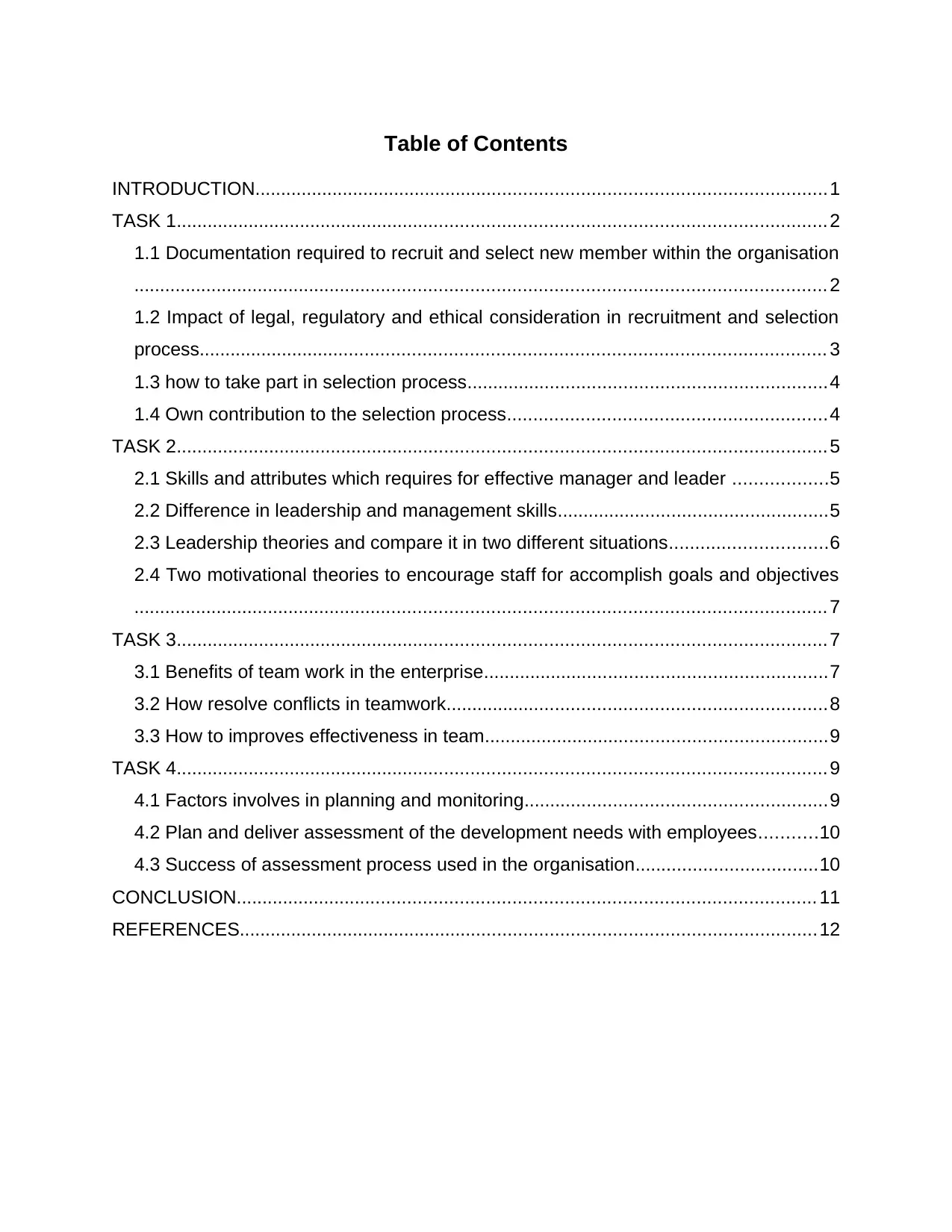
Table of Contents
INTRODUCTION..............................................................................................................1
TASK 1.............................................................................................................................2
1.1 Documentation required to recruit and select new member within the organisation
..................................................................................................................................... 2
1.2 Impact of legal, regulatory and ethical consideration in recruitment and selection
process........................................................................................................................ 3
1.3 how to take part in selection process.....................................................................4
1.4 Own contribution to the selection process.............................................................4
TASK 2.............................................................................................................................5
2.1 Skills and attributes which requires for effective manager and leader ..................5
2.2 Difference in leadership and management skills....................................................5
2.3 Leadership theories and compare it in two different situations..............................6
2.4 Two motivational theories to encourage staff for accomplish goals and objectives
..................................................................................................................................... 7
TASK 3.............................................................................................................................7
3.1 Benefits of team work in the enterprise..................................................................7
3.2 How resolve conflicts in teamwork.........................................................................8
3.3 How to improves effectiveness in team..................................................................9
TASK 4.............................................................................................................................9
4.1 Factors involves in planning and monitoring..........................................................9
4.2 Plan and deliver assessment of the development needs with employees...........10
4.3 Success of assessment process used in the organisation...................................10
CONCLUSION............................................................................................................... 11
REFERENCES...............................................................................................................12
INTRODUCTION..............................................................................................................1
TASK 1.............................................................................................................................2
1.1 Documentation required to recruit and select new member within the organisation
..................................................................................................................................... 2
1.2 Impact of legal, regulatory and ethical consideration in recruitment and selection
process........................................................................................................................ 3
1.3 how to take part in selection process.....................................................................4
1.4 Own contribution to the selection process.............................................................4
TASK 2.............................................................................................................................5
2.1 Skills and attributes which requires for effective manager and leader ..................5
2.2 Difference in leadership and management skills....................................................5
2.3 Leadership theories and compare it in two different situations..............................6
2.4 Two motivational theories to encourage staff for accomplish goals and objectives
..................................................................................................................................... 7
TASK 3.............................................................................................................................7
3.1 Benefits of team work in the enterprise..................................................................7
3.2 How resolve conflicts in teamwork.........................................................................8
3.3 How to improves effectiveness in team..................................................................9
TASK 4.............................................................................................................................9
4.1 Factors involves in planning and monitoring..........................................................9
4.2 Plan and deliver assessment of the development needs with employees...........10
4.3 Success of assessment process used in the organisation...................................10
CONCLUSION............................................................................................................... 11
REFERENCES...............................................................................................................12

⊘ This is a preview!⊘
Do you want full access?
Subscribe today to unlock all pages.

Trusted by 1+ million students worldwide
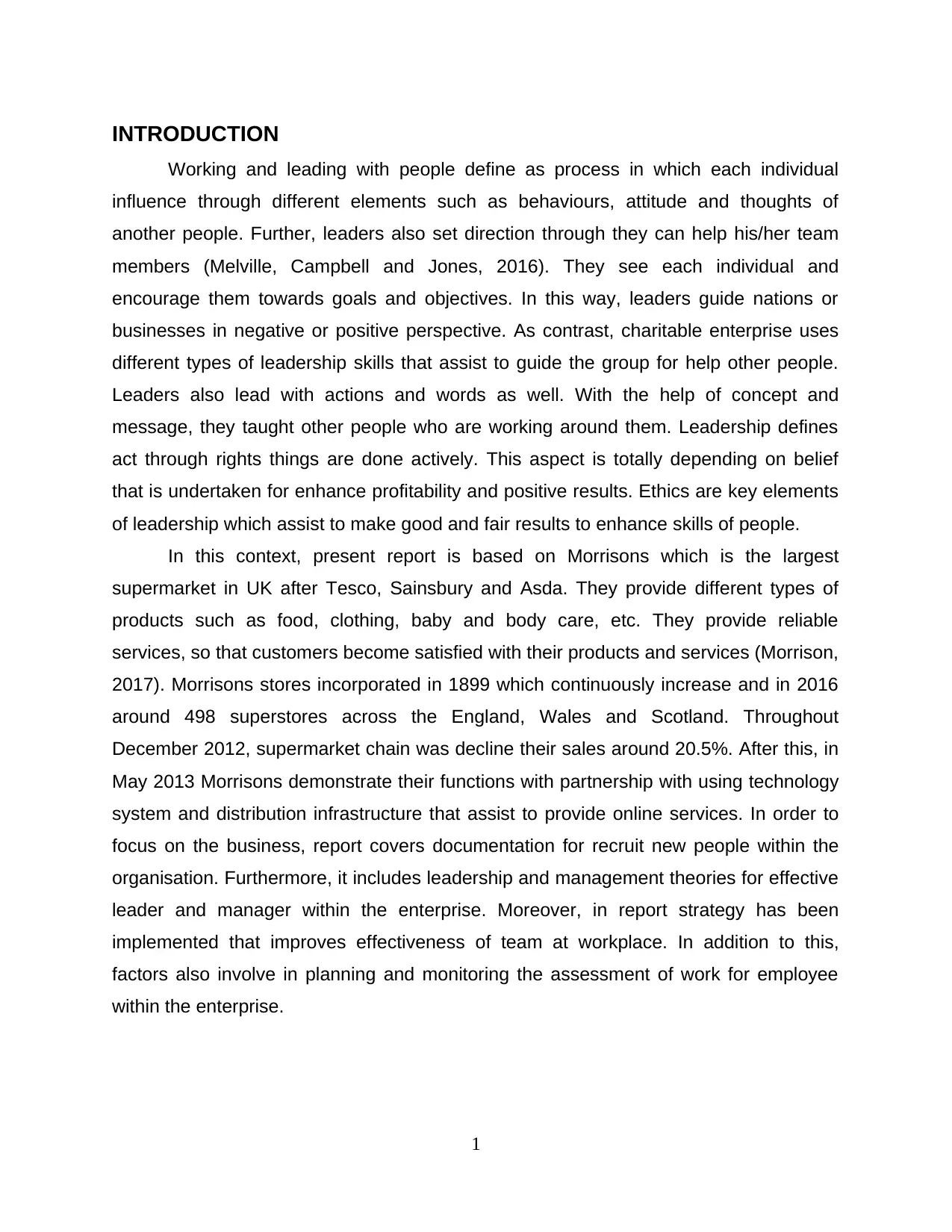
INTRODUCTION
Working and leading with people define as process in which each individual
influence through different elements such as behaviours, attitude and thoughts of
another people. Further, leaders also set direction through they can help his/her team
members (Melville, Campbell and Jones, 2016). They see each individual and
encourage them towards goals and objectives. In this way, leaders guide nations or
businesses in negative or positive perspective. As contrast, charitable enterprise uses
different types of leadership skills that assist to guide the group for help other people.
Leaders also lead with actions and words as well. With the help of concept and
message, they taught other people who are working around them. Leadership defines
act through rights things are done actively. This aspect is totally depending on belief
that is undertaken for enhance profitability and positive results. Ethics are key elements
of leadership which assist to make good and fair results to enhance skills of people.
In this context, present report is based on Morrisons which is the largest
supermarket in UK after Tesco, Sainsbury and Asda. They provide different types of
products such as food, clothing, baby and body care, etc. They provide reliable
services, so that customers become satisfied with their products and services (Morrison,
2017). Morrisons stores incorporated in 1899 which continuously increase and in 2016
around 498 superstores across the England, Wales and Scotland. Throughout
December 2012, supermarket chain was decline their sales around 20.5%. After this, in
May 2013 Morrisons demonstrate their functions with partnership with using technology
system and distribution infrastructure that assist to provide online services. In order to
focus on the business, report covers documentation for recruit new people within the
organisation. Furthermore, it includes leadership and management theories for effective
leader and manager within the enterprise. Moreover, in report strategy has been
implemented that improves effectiveness of team at workplace. In addition to this,
factors also involve in planning and monitoring the assessment of work for employee
within the enterprise.
1
Working and leading with people define as process in which each individual
influence through different elements such as behaviours, attitude and thoughts of
another people. Further, leaders also set direction through they can help his/her team
members (Melville, Campbell and Jones, 2016). They see each individual and
encourage them towards goals and objectives. In this way, leaders guide nations or
businesses in negative or positive perspective. As contrast, charitable enterprise uses
different types of leadership skills that assist to guide the group for help other people.
Leaders also lead with actions and words as well. With the help of concept and
message, they taught other people who are working around them. Leadership defines
act through rights things are done actively. This aspect is totally depending on belief
that is undertaken for enhance profitability and positive results. Ethics are key elements
of leadership which assist to make good and fair results to enhance skills of people.
In this context, present report is based on Morrisons which is the largest
supermarket in UK after Tesco, Sainsbury and Asda. They provide different types of
products such as food, clothing, baby and body care, etc. They provide reliable
services, so that customers become satisfied with their products and services (Morrison,
2017). Morrisons stores incorporated in 1899 which continuously increase and in 2016
around 498 superstores across the England, Wales and Scotland. Throughout
December 2012, supermarket chain was decline their sales around 20.5%. After this, in
May 2013 Morrisons demonstrate their functions with partnership with using technology
system and distribution infrastructure that assist to provide online services. In order to
focus on the business, report covers documentation for recruit new people within the
organisation. Furthermore, it includes leadership and management theories for effective
leader and manager within the enterprise. Moreover, in report strategy has been
implemented that improves effectiveness of team at workplace. In addition to this,
factors also involve in planning and monitoring the assessment of work for employee
within the enterprise.
1
Paraphrase This Document
Need a fresh take? Get an instant paraphrase of this document with our AI Paraphraser
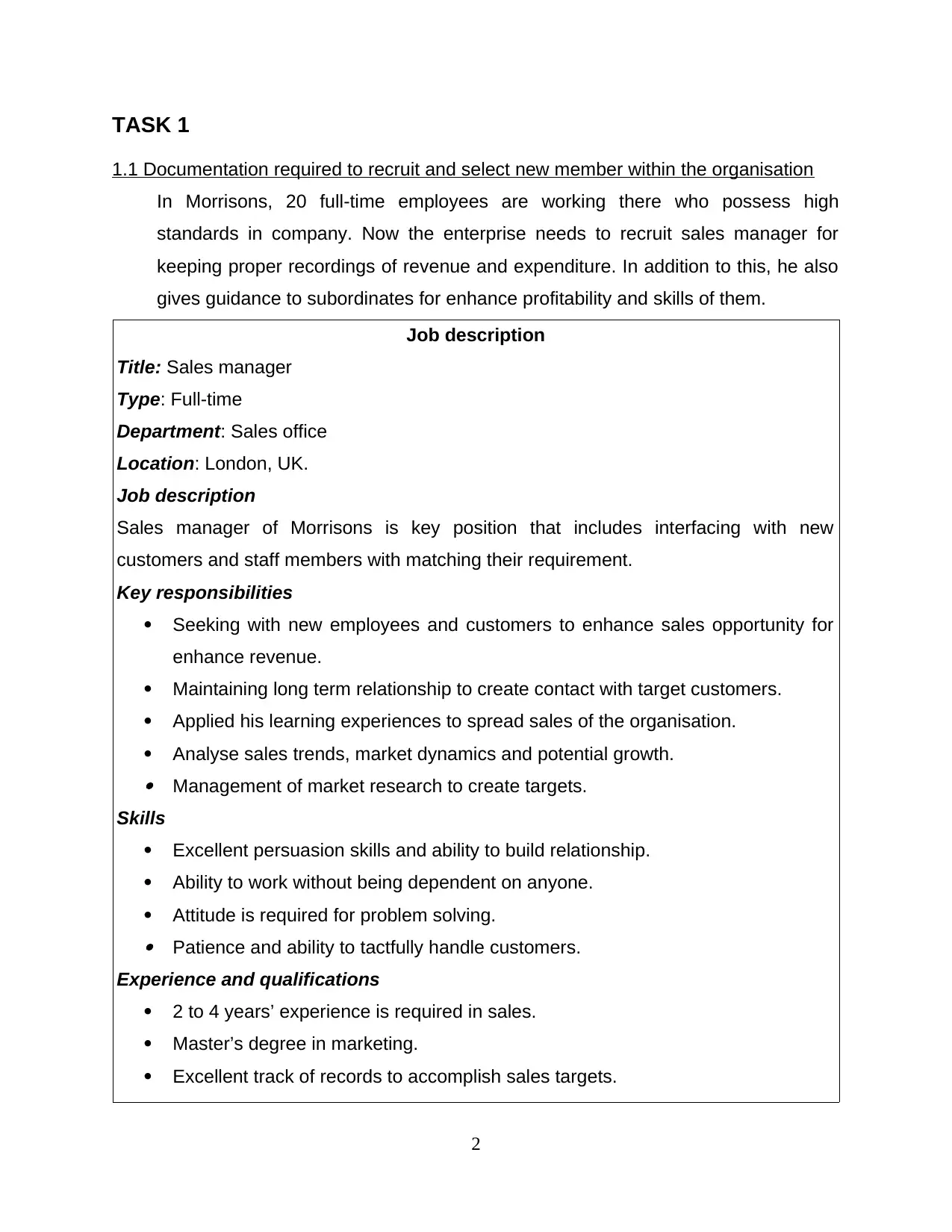
TASK 1
1.1 Documentation required to recruit and select new member within the organisation
In Morrisons, 20 full-time employees are working there who possess high
standards in company. Now the enterprise needs to recruit sales manager for
keeping proper recordings of revenue and expenditure. In addition to this, he also
gives guidance to subordinates for enhance profitability and skills of them.
Job description
Title: Sales manager
Type: Full-time
Department: Sales office
Location: London, UK.
Job description
Sales manager of Morrisons is key position that includes interfacing with new
customers and staff members with matching their requirement.
Key responsibilities
Seeking with new employees and customers to enhance sales opportunity for
enhance revenue.
Maintaining long term relationship to create contact with target customers.
Applied his learning experiences to spread sales of the organisation.
Analyse sales trends, market dynamics and potential growth. Management of market research to create targets.
Skills
Excellent persuasion skills and ability to build relationship.
Ability to work without being dependent on anyone.
Attitude is required for problem solving. Patience and ability to tactfully handle customers.
Experience and qualifications
2 to 4 years’ experience is required in sales.
Master’s degree in marketing.
Excellent track of records to accomplish sales targets.
2
1.1 Documentation required to recruit and select new member within the organisation
In Morrisons, 20 full-time employees are working there who possess high
standards in company. Now the enterprise needs to recruit sales manager for
keeping proper recordings of revenue and expenditure. In addition to this, he also
gives guidance to subordinates for enhance profitability and skills of them.
Job description
Title: Sales manager
Type: Full-time
Department: Sales office
Location: London, UK.
Job description
Sales manager of Morrisons is key position that includes interfacing with new
customers and staff members with matching their requirement.
Key responsibilities
Seeking with new employees and customers to enhance sales opportunity for
enhance revenue.
Maintaining long term relationship to create contact with target customers.
Applied his learning experiences to spread sales of the organisation.
Analyse sales trends, market dynamics and potential growth. Management of market research to create targets.
Skills
Excellent persuasion skills and ability to build relationship.
Ability to work without being dependent on anyone.
Attitude is required for problem solving. Patience and ability to tactfully handle customers.
Experience and qualifications
2 to 4 years’ experience is required in sales.
Master’s degree in marketing.
Excellent track of records to accomplish sales targets.
2
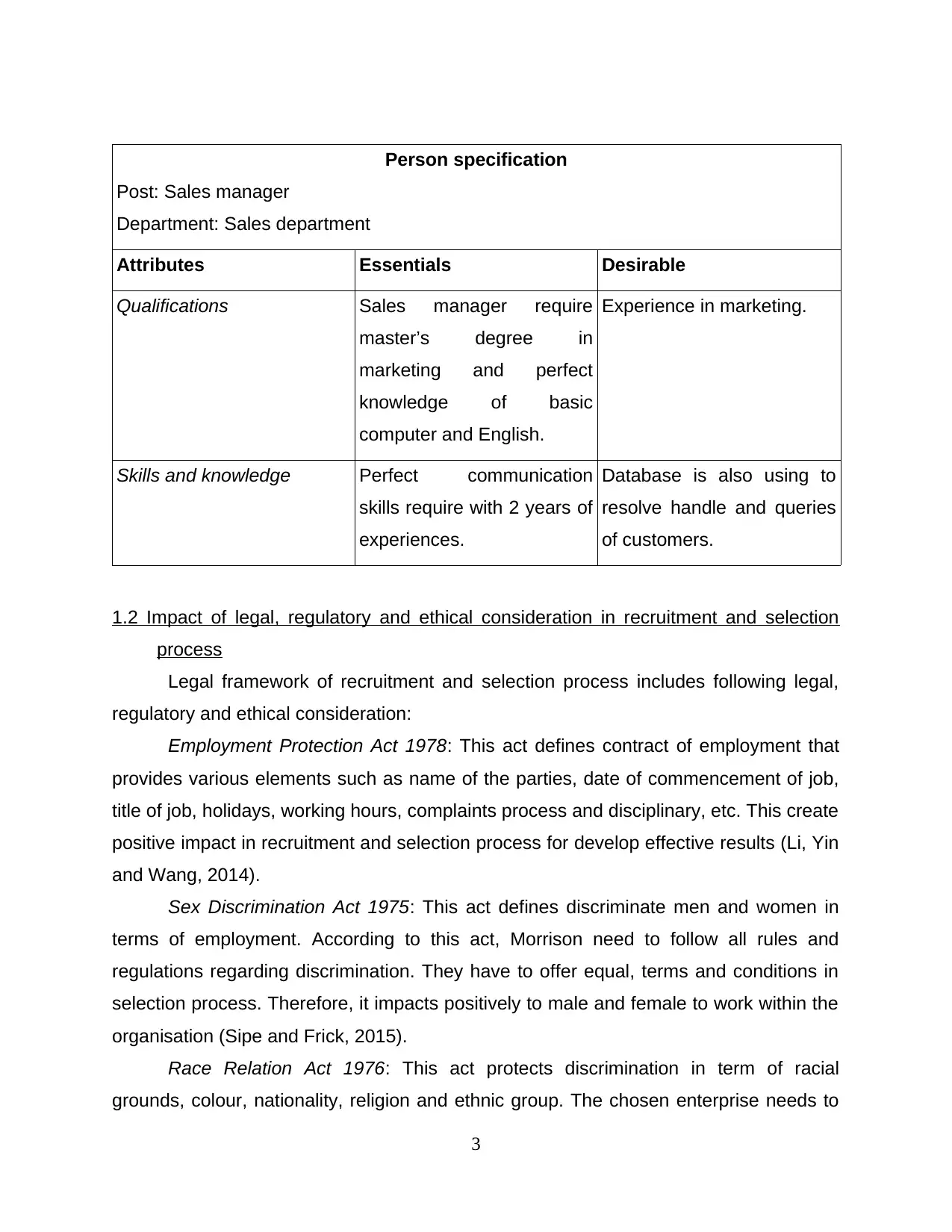
Person specification
Post: Sales manager
Department: Sales department
Attributes Essentials Desirable
Qualifications Sales manager require
master’s degree in
marketing and perfect
knowledge of basic
computer and English.
Experience in marketing.
Skills and knowledge Perfect communication
skills require with 2 years of
experiences.
Database is also using to
resolve handle and queries
of customers.
1.2 Impact of legal, regulatory and ethical consideration in recruitment and selection
process
Legal framework of recruitment and selection process includes following legal,
regulatory and ethical consideration:
Employment Protection Act 1978: This act defines contract of employment that
provides various elements such as name of the parties, date of commencement of job,
title of job, holidays, working hours, complaints process and disciplinary, etc. This create
positive impact in recruitment and selection process for develop effective results (Li, Yin
and Wang, 2014).
Sex Discrimination Act 1975: This act defines discriminate men and women in
terms of employment. According to this act, Morrison need to follow all rules and
regulations regarding discrimination. They have to offer equal, terms and conditions in
selection process. Therefore, it impacts positively to male and female to work within the
organisation (Sipe and Frick, 2015).
Race Relation Act 1976: This act protects discrimination in term of racial
grounds, colour, nationality, religion and ethnic group. The chosen enterprise needs to
3
Post: Sales manager
Department: Sales department
Attributes Essentials Desirable
Qualifications Sales manager require
master’s degree in
marketing and perfect
knowledge of basic
computer and English.
Experience in marketing.
Skills and knowledge Perfect communication
skills require with 2 years of
experiences.
Database is also using to
resolve handle and queries
of customers.
1.2 Impact of legal, regulatory and ethical consideration in recruitment and selection
process
Legal framework of recruitment and selection process includes following legal,
regulatory and ethical consideration:
Employment Protection Act 1978: This act defines contract of employment that
provides various elements such as name of the parties, date of commencement of job,
title of job, holidays, working hours, complaints process and disciplinary, etc. This create
positive impact in recruitment and selection process for develop effective results (Li, Yin
and Wang, 2014).
Sex Discrimination Act 1975: This act defines discriminate men and women in
terms of employment. According to this act, Morrison need to follow all rules and
regulations regarding discrimination. They have to offer equal, terms and conditions in
selection process. Therefore, it impacts positively to male and female to work within the
organisation (Sipe and Frick, 2015).
Race Relation Act 1976: This act protects discrimination in term of racial
grounds, colour, nationality, religion and ethnic group. The chosen enterprise needs to
3
⊘ This is a preview!⊘
Do you want full access?
Subscribe today to unlock all pages.

Trusted by 1+ million students worldwide
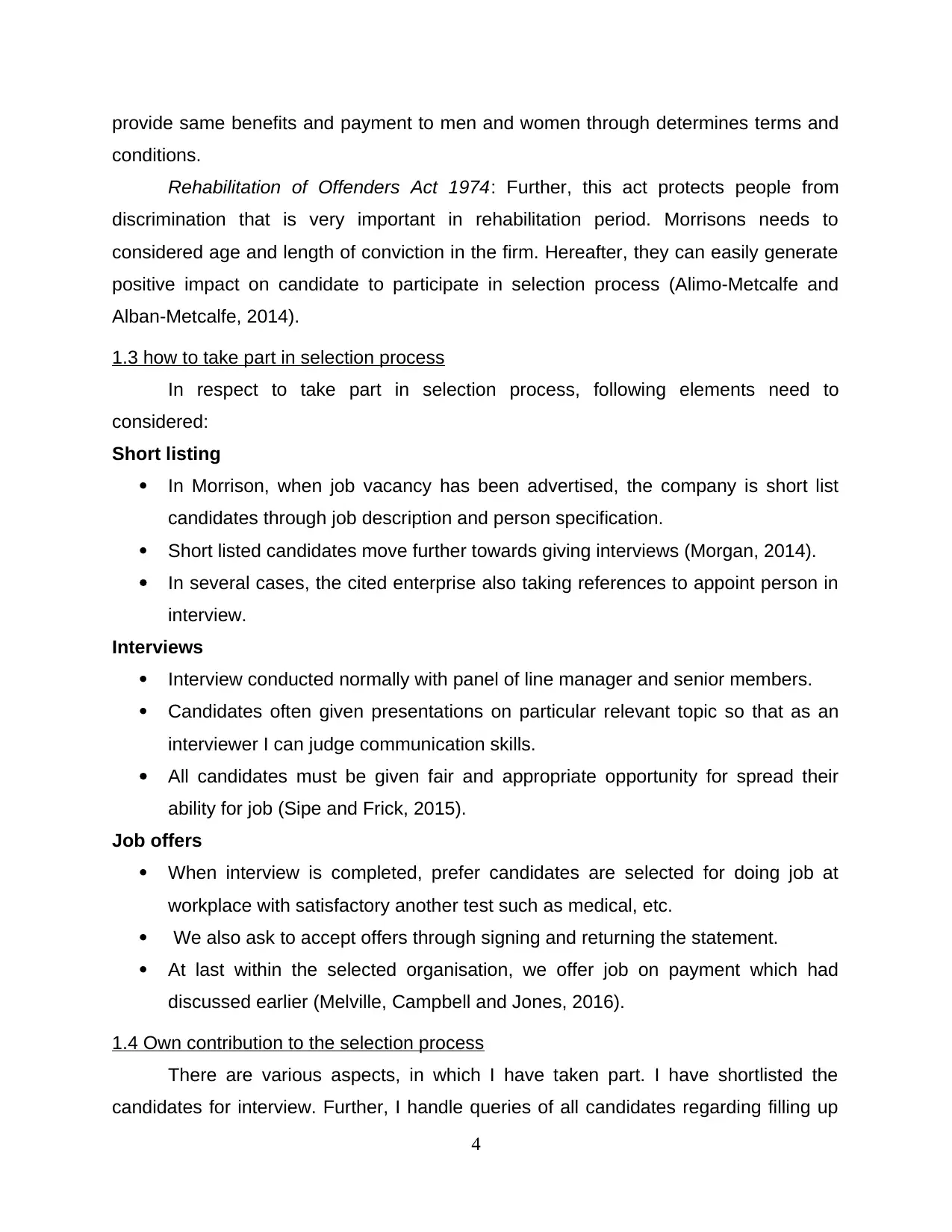
provide same benefits and payment to men and women through determines terms and
conditions.
Rehabilitation of Offenders Act 1974: Further, this act protects people from
discrimination that is very important in rehabilitation period. Morrisons needs to
considered age and length of conviction in the firm. Hereafter, they can easily generate
positive impact on candidate to participate in selection process (Alimo-Metcalfe and
Alban-Metcalfe, 2014).
1.3 how to take part in selection process
In respect to take part in selection process, following elements need to
considered:
Short listing
In Morrison, when job vacancy has been advertised, the company is short list
candidates through job description and person specification.
Short listed candidates move further towards giving interviews (Morgan, 2014).
In several cases, the cited enterprise also taking references to appoint person in
interview.
Interviews
Interview conducted normally with panel of line manager and senior members.
Candidates often given presentations on particular relevant topic so that as an
interviewer I can judge communication skills.
All candidates must be given fair and appropriate opportunity for spread their
ability for job (Sipe and Frick, 2015).
Job offers
When interview is completed, prefer candidates are selected for doing job at
workplace with satisfactory another test such as medical, etc.
We also ask to accept offers through signing and returning the statement.
At last within the selected organisation, we offer job on payment which had
discussed earlier (Melville, Campbell and Jones, 2016).
1.4 Own contribution to the selection process
There are various aspects, in which I have taken part. I have shortlisted the
candidates for interview. Further, I handle queries of all candidates regarding filling up
4
conditions.
Rehabilitation of Offenders Act 1974: Further, this act protects people from
discrimination that is very important in rehabilitation period. Morrisons needs to
considered age and length of conviction in the firm. Hereafter, they can easily generate
positive impact on candidate to participate in selection process (Alimo-Metcalfe and
Alban-Metcalfe, 2014).
1.3 how to take part in selection process
In respect to take part in selection process, following elements need to
considered:
Short listing
In Morrison, when job vacancy has been advertised, the company is short list
candidates through job description and person specification.
Short listed candidates move further towards giving interviews (Morgan, 2014).
In several cases, the cited enterprise also taking references to appoint person in
interview.
Interviews
Interview conducted normally with panel of line manager and senior members.
Candidates often given presentations on particular relevant topic so that as an
interviewer I can judge communication skills.
All candidates must be given fair and appropriate opportunity for spread their
ability for job (Sipe and Frick, 2015).
Job offers
When interview is completed, prefer candidates are selected for doing job at
workplace with satisfactory another test such as medical, etc.
We also ask to accept offers through signing and returning the statement.
At last within the selected organisation, we offer job on payment which had
discussed earlier (Melville, Campbell and Jones, 2016).
1.4 Own contribution to the selection process
There are various aspects, in which I have taken part. I have shortlisted the
candidates for interview. Further, I handle queries of all candidates regarding filling up
4
Paraphrase This Document
Need a fresh take? Get an instant paraphrase of this document with our AI Paraphraser
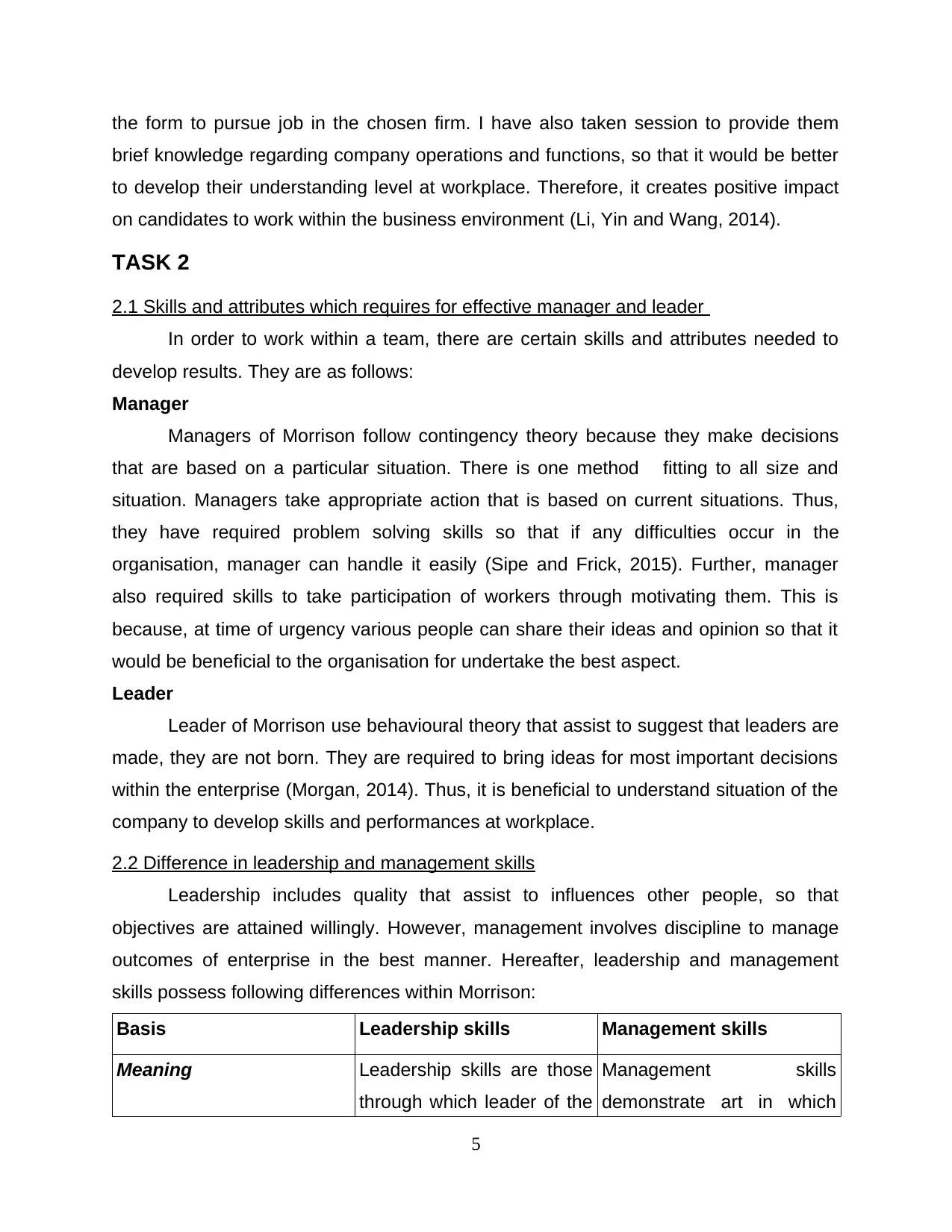
the form to pursue job in the chosen firm. I have also taken session to provide them
brief knowledge regarding company operations and functions, so that it would be better
to develop their understanding level at workplace. Therefore, it creates positive impact
on candidates to work within the business environment (Li, Yin and Wang, 2014).
TASK 2
2.1 Skills and attributes which requires for effective manager and leader
In order to work within a team, there are certain skills and attributes needed to
develop results. They are as follows:
Manager
Managers of Morrison follow contingency theory because they make decisions
that are based on a particular situation. There is one method fitting to all size and
situation. Managers take appropriate action that is based on current situations. Thus,
they have required problem solving skills so that if any difficulties occur in the
organisation, manager can handle it easily (Sipe and Frick, 2015). Further, manager
also required skills to take participation of workers through motivating them. This is
because, at time of urgency various people can share their ideas and opinion so that it
would be beneficial to the organisation for undertake the best aspect.
Leader
Leader of Morrison use behavioural theory that assist to suggest that leaders are
made, they are not born. They are required to bring ideas for most important decisions
within the enterprise (Morgan, 2014). Thus, it is beneficial to understand situation of the
company to develop skills and performances at workplace.
2.2 Difference in leadership and management skills
Leadership includes quality that assist to influences other people, so that
objectives are attained willingly. However, management involves discipline to manage
outcomes of enterprise in the best manner. Hereafter, leadership and management
skills possess following differences within Morrison:
Basis Leadership skills Management skills
Meaning Leadership skills are those
through which leader of the
Management skills
demonstrate art in which
5
brief knowledge regarding company operations and functions, so that it would be better
to develop their understanding level at workplace. Therefore, it creates positive impact
on candidates to work within the business environment (Li, Yin and Wang, 2014).
TASK 2
2.1 Skills and attributes which requires for effective manager and leader
In order to work within a team, there are certain skills and attributes needed to
develop results. They are as follows:
Manager
Managers of Morrison follow contingency theory because they make decisions
that are based on a particular situation. There is one method fitting to all size and
situation. Managers take appropriate action that is based on current situations. Thus,
they have required problem solving skills so that if any difficulties occur in the
organisation, manager can handle it easily (Sipe and Frick, 2015). Further, manager
also required skills to take participation of workers through motivating them. This is
because, at time of urgency various people can share their ideas and opinion so that it
would be beneficial to the organisation for undertake the best aspect.
Leader
Leader of Morrison use behavioural theory that assist to suggest that leaders are
made, they are not born. They are required to bring ideas for most important decisions
within the enterprise (Morgan, 2014). Thus, it is beneficial to understand situation of the
company to develop skills and performances at workplace.
2.2 Difference in leadership and management skills
Leadership includes quality that assist to influences other people, so that
objectives are attained willingly. However, management involves discipline to manage
outcomes of enterprise in the best manner. Hereafter, leadership and management
skills possess following differences within Morrison:
Basis Leadership skills Management skills
Meaning Leadership skills are those
through which leader of the
Management skills
demonstrate art in which
5
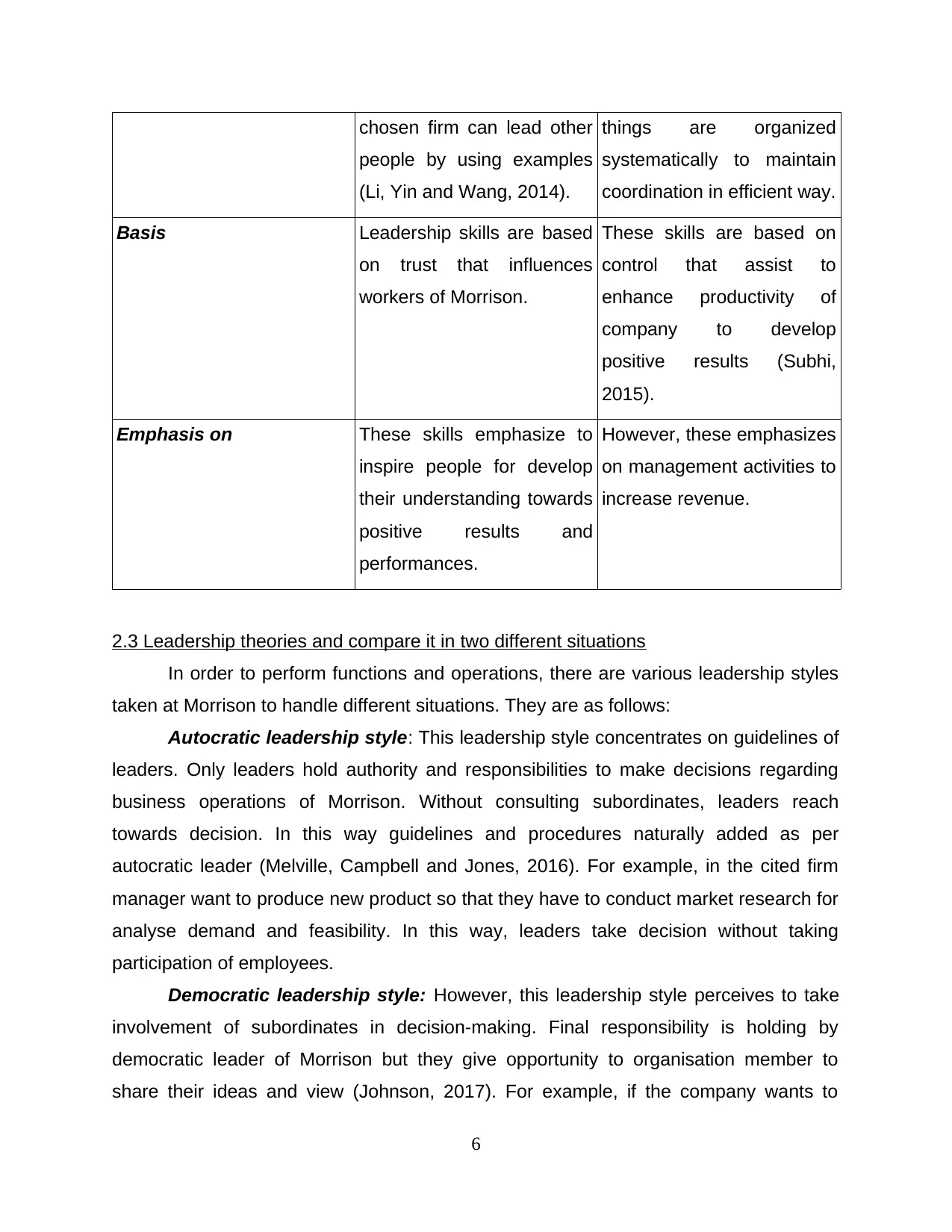
chosen firm can lead other
people by using examples
(Li, Yin and Wang, 2014).
things are organized
systematically to maintain
coordination in efficient way.
Basis Leadership skills are based
on trust that influences
workers of Morrison.
These skills are based on
control that assist to
enhance productivity of
company to develop
positive results (Subhi,
2015).
Emphasis on These skills emphasize to
inspire people for develop
their understanding towards
positive results and
performances.
However, these emphasizes
on management activities to
increase revenue.
2.3 Leadership theories and compare it in two different situations
In order to perform functions and operations, there are various leadership styles
taken at Morrison to handle different situations. They are as follows:
Autocratic leadership style: This leadership style concentrates on guidelines of
leaders. Only leaders hold authority and responsibilities to make decisions regarding
business operations of Morrison. Without consulting subordinates, leaders reach
towards decision. In this way guidelines and procedures naturally added as per
autocratic leader (Melville, Campbell and Jones, 2016). For example, in the cited firm
manager want to produce new product so that they have to conduct market research for
analyse demand and feasibility. In this way, leaders take decision without taking
participation of employees.
Democratic leadership style: However, this leadership style perceives to take
involvement of subordinates in decision-making. Final responsibility is holding by
democratic leader of Morrison but they give opportunity to organisation member to
share their ideas and view (Johnson, 2017). For example, if the company wants to
6
people by using examples
(Li, Yin and Wang, 2014).
things are organized
systematically to maintain
coordination in efficient way.
Basis Leadership skills are based
on trust that influences
workers of Morrison.
These skills are based on
control that assist to
enhance productivity of
company to develop
positive results (Subhi,
2015).
Emphasis on These skills emphasize to
inspire people for develop
their understanding towards
positive results and
performances.
However, these emphasizes
on management activities to
increase revenue.
2.3 Leadership theories and compare it in two different situations
In order to perform functions and operations, there are various leadership styles
taken at Morrison to handle different situations. They are as follows:
Autocratic leadership style: This leadership style concentrates on guidelines of
leaders. Only leaders hold authority and responsibilities to make decisions regarding
business operations of Morrison. Without consulting subordinates, leaders reach
towards decision. In this way guidelines and procedures naturally added as per
autocratic leader (Melville, Campbell and Jones, 2016). For example, in the cited firm
manager want to produce new product so that they have to conduct market research for
analyse demand and feasibility. In this way, leaders take decision without taking
participation of employees.
Democratic leadership style: However, this leadership style perceives to take
involvement of subordinates in decision-making. Final responsibility is holding by
democratic leader of Morrison but they give opportunity to organisation member to
share their ideas and view (Johnson, 2017). For example, if the company wants to
6
⊘ This is a preview!⊘
Do you want full access?
Subscribe today to unlock all pages.

Trusted by 1+ million students worldwide
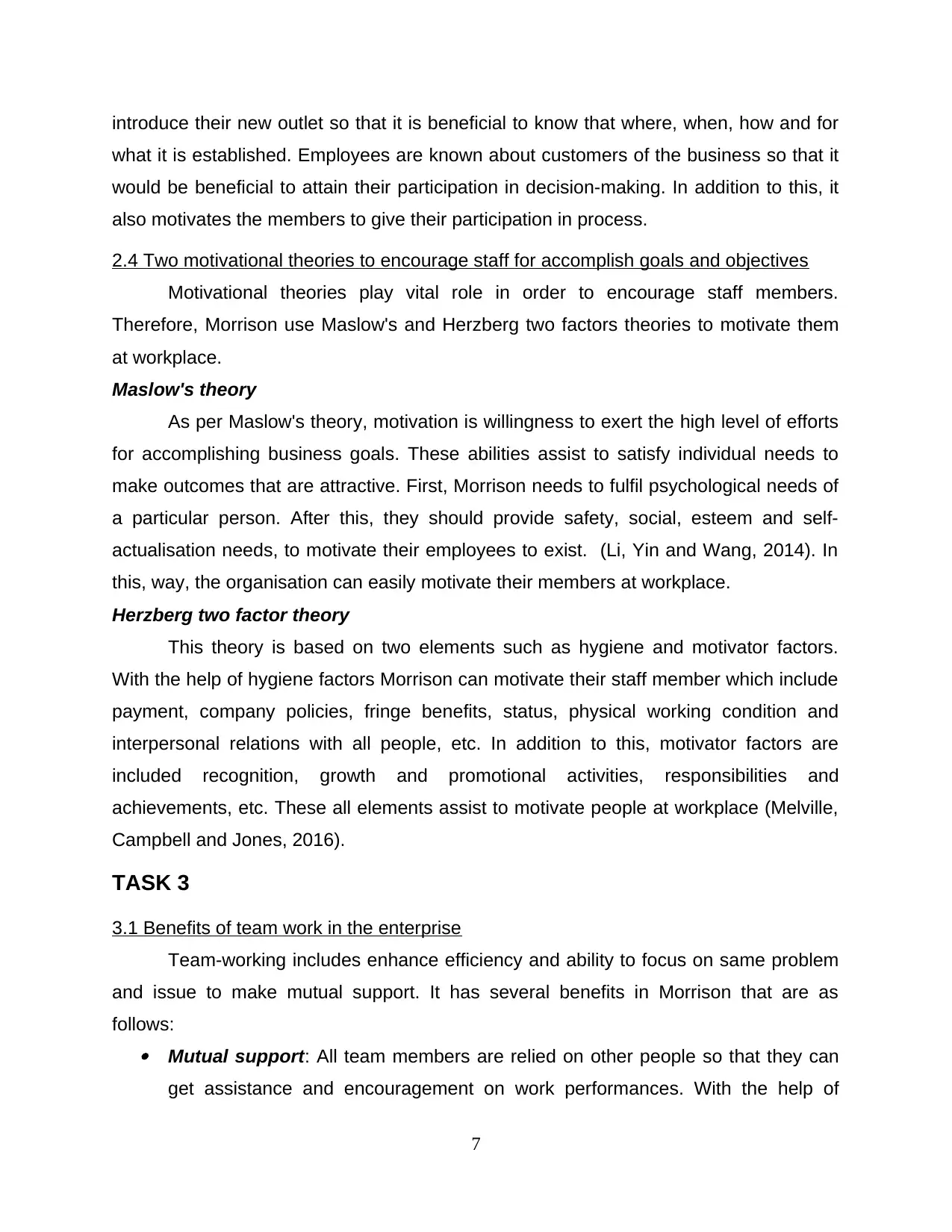
introduce their new outlet so that it is beneficial to know that where, when, how and for
what it is established. Employees are known about customers of the business so that it
would be beneficial to attain their participation in decision-making. In addition to this, it
also motivates the members to give their participation in process.
2.4 Two motivational theories to encourage staff for accomplish goals and objectives
Motivational theories play vital role in order to encourage staff members.
Therefore, Morrison use Maslow's and Herzberg two factors theories to motivate them
at workplace.
Maslow's theory
As per Maslow's theory, motivation is willingness to exert the high level of efforts
for accomplishing business goals. These abilities assist to satisfy individual needs to
make outcomes that are attractive. First, Morrison needs to fulfil psychological needs of
a particular person. After this, they should provide safety, social, esteem and self-
actualisation needs, to motivate their employees to exist. (Li, Yin and Wang, 2014). In
this, way, the organisation can easily motivate their members at workplace.
Herzberg two factor theory
This theory is based on two elements such as hygiene and motivator factors.
With the help of hygiene factors Morrison can motivate their staff member which include
payment, company policies, fringe benefits, status, physical working condition and
interpersonal relations with all people, etc. In addition to this, motivator factors are
included recognition, growth and promotional activities, responsibilities and
achievements, etc. These all elements assist to motivate people at workplace (Melville,
Campbell and Jones, 2016).
TASK 3
3.1 Benefits of team work in the enterprise
Team-working includes enhance efficiency and ability to focus on same problem
and issue to make mutual support. It has several benefits in Morrison that are as
follows: Mutual support: All team members are relied on other people so that they can
get assistance and encouragement on work performances. With the help of
7
what it is established. Employees are known about customers of the business so that it
would be beneficial to attain their participation in decision-making. In addition to this, it
also motivates the members to give their participation in process.
2.4 Two motivational theories to encourage staff for accomplish goals and objectives
Motivational theories play vital role in order to encourage staff members.
Therefore, Morrison use Maslow's and Herzberg two factors theories to motivate them
at workplace.
Maslow's theory
As per Maslow's theory, motivation is willingness to exert the high level of efforts
for accomplishing business goals. These abilities assist to satisfy individual needs to
make outcomes that are attractive. First, Morrison needs to fulfil psychological needs of
a particular person. After this, they should provide safety, social, esteem and self-
actualisation needs, to motivate their employees to exist. (Li, Yin and Wang, 2014). In
this, way, the organisation can easily motivate their members at workplace.
Herzberg two factor theory
This theory is based on two elements such as hygiene and motivator factors.
With the help of hygiene factors Morrison can motivate their staff member which include
payment, company policies, fringe benefits, status, physical working condition and
interpersonal relations with all people, etc. In addition to this, motivator factors are
included recognition, growth and promotional activities, responsibilities and
achievements, etc. These all elements assist to motivate people at workplace (Melville,
Campbell and Jones, 2016).
TASK 3
3.1 Benefits of team work in the enterprise
Team-working includes enhance efficiency and ability to focus on same problem
and issue to make mutual support. It has several benefits in Morrison that are as
follows: Mutual support: All team members are relied on other people so that they can
get assistance and encouragement on work performances. With the help of
7
Paraphrase This Document
Need a fresh take? Get an instant paraphrase of this document with our AI Paraphraser
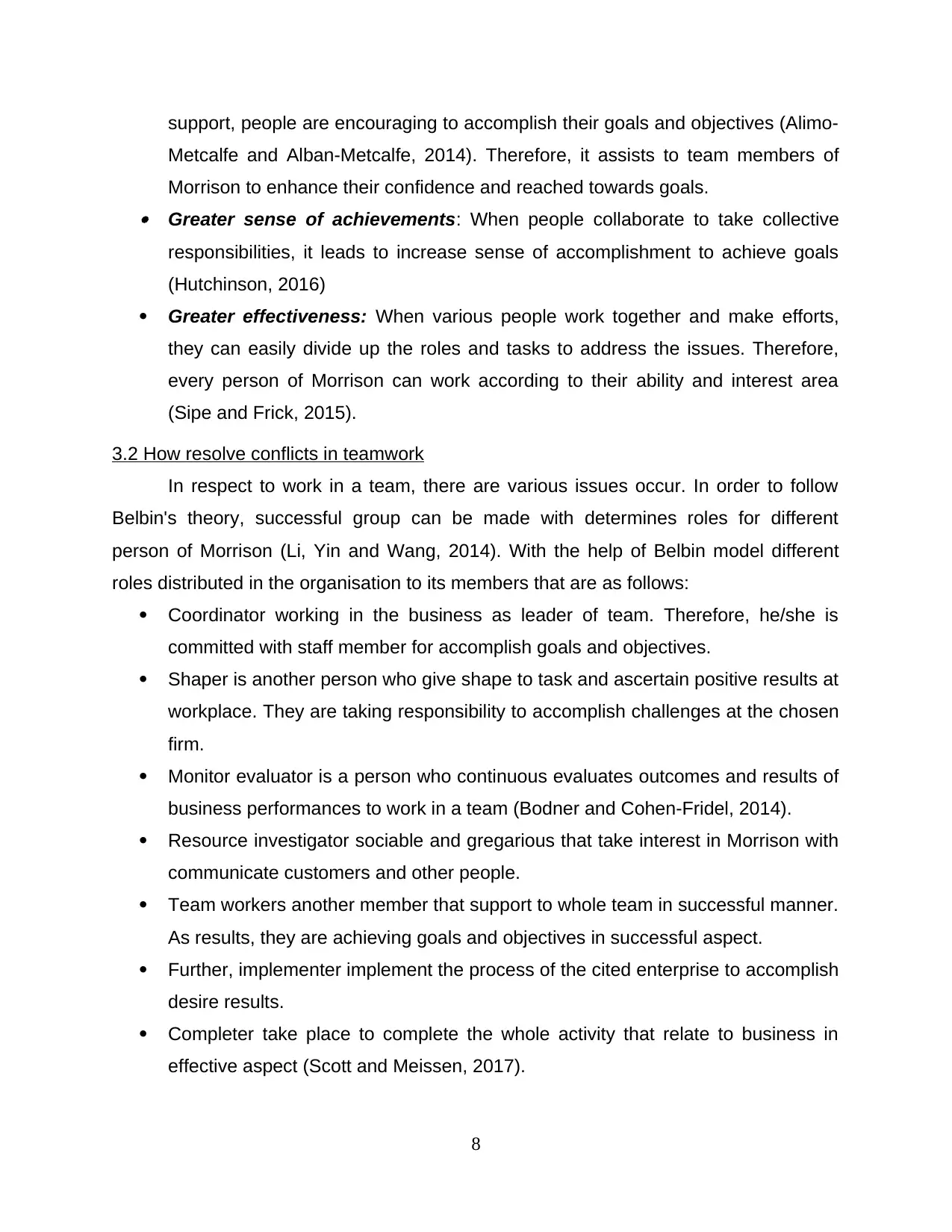
support, people are encouraging to accomplish their goals and objectives (Alimo-
Metcalfe and Alban-Metcalfe, 2014). Therefore, it assists to team members of
Morrison to enhance their confidence and reached towards goals. Greater sense of achievements: When people collaborate to take collective
responsibilities, it leads to increase sense of accomplishment to achieve goals
(Hutchinson, 2016)
Greater effectiveness: When various people work together and make efforts,
they can easily divide up the roles and tasks to address the issues. Therefore,
every person of Morrison can work according to their ability and interest area
(Sipe and Frick, 2015).
3.2 How resolve conflicts in teamwork
In respect to work in a team, there are various issues occur. In order to follow
Belbin's theory, successful group can be made with determines roles for different
person of Morrison (Li, Yin and Wang, 2014). With the help of Belbin model different
roles distributed in the organisation to its members that are as follows:
Coordinator working in the business as leader of team. Therefore, he/she is
committed with staff member for accomplish goals and objectives.
Shaper is another person who give shape to task and ascertain positive results at
workplace. They are taking responsibility to accomplish challenges at the chosen
firm.
Monitor evaluator is a person who continuous evaluates outcomes and results of
business performances to work in a team (Bodner and Cohen-Fridel, 2014).
Resource investigator sociable and gregarious that take interest in Morrison with
communicate customers and other people.
Team workers another member that support to whole team in successful manner.
As results, they are achieving goals and objectives in successful aspect.
Further, implementer implement the process of the cited enterprise to accomplish
desire results.
Completer take place to complete the whole activity that relate to business in
effective aspect (Scott and Meissen, 2017).
8
Metcalfe and Alban-Metcalfe, 2014). Therefore, it assists to team members of
Morrison to enhance their confidence and reached towards goals. Greater sense of achievements: When people collaborate to take collective
responsibilities, it leads to increase sense of accomplishment to achieve goals
(Hutchinson, 2016)
Greater effectiveness: When various people work together and make efforts,
they can easily divide up the roles and tasks to address the issues. Therefore,
every person of Morrison can work according to their ability and interest area
(Sipe and Frick, 2015).
3.2 How resolve conflicts in teamwork
In respect to work in a team, there are various issues occur. In order to follow
Belbin's theory, successful group can be made with determines roles for different
person of Morrison (Li, Yin and Wang, 2014). With the help of Belbin model different
roles distributed in the organisation to its members that are as follows:
Coordinator working in the business as leader of team. Therefore, he/she is
committed with staff member for accomplish goals and objectives.
Shaper is another person who give shape to task and ascertain positive results at
workplace. They are taking responsibility to accomplish challenges at the chosen
firm.
Monitor evaluator is a person who continuous evaluates outcomes and results of
business performances to work in a team (Bodner and Cohen-Fridel, 2014).
Resource investigator sociable and gregarious that take interest in Morrison with
communicate customers and other people.
Team workers another member that support to whole team in successful manner.
As results, they are achieving goals and objectives in successful aspect.
Further, implementer implement the process of the cited enterprise to accomplish
desire results.
Completer take place to complete the whole activity that relate to business in
effective aspect (Scott and Meissen, 2017).
8
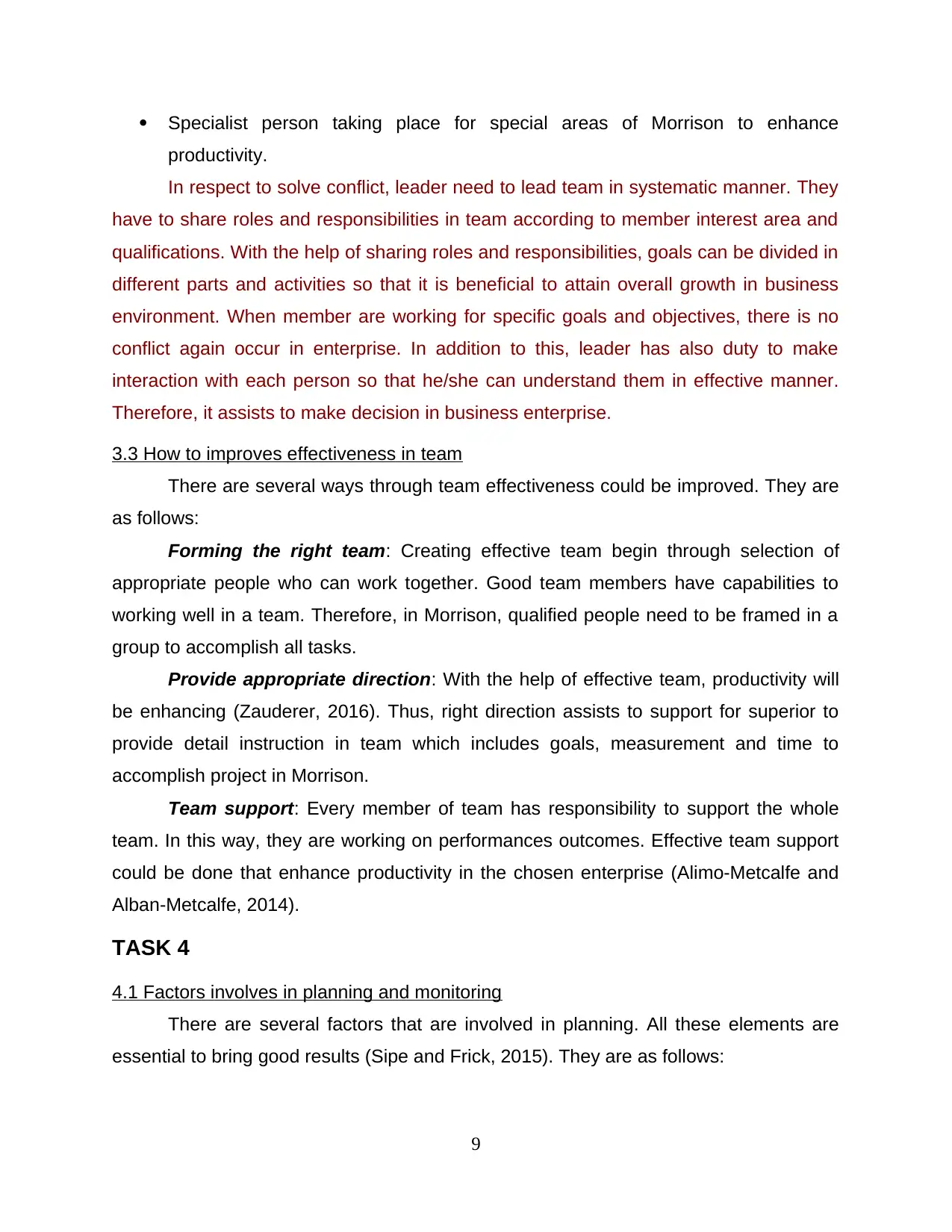
Specialist person taking place for special areas of Morrison to enhance
productivity.
In respect to solve conflict, leader need to lead team in systematic manner. They
have to share roles and responsibilities in team according to member interest area and
qualifications. With the help of sharing roles and responsibilities, goals can be divided in
different parts and activities so that it is beneficial to attain overall growth in business
environment. When member are working for specific goals and objectives, there is no
conflict again occur in enterprise. In addition to this, leader has also duty to make
interaction with each person so that he/she can understand them in effective manner.
Therefore, it assists to make decision in business enterprise.
3.3 How to improves effectiveness in team
There are several ways through team effectiveness could be improved. They are
as follows:
Forming the right team: Creating effective team begin through selection of
appropriate people who can work together. Good team members have capabilities to
working well in a team. Therefore, in Morrison, qualified people need to be framed in a
group to accomplish all tasks.
Provide appropriate direction: With the help of effective team, productivity will
be enhancing (Zauderer, 2016). Thus, right direction assists to support for superior to
provide detail instruction in team which includes goals, measurement and time to
accomplish project in Morrison.
Team support: Every member of team has responsibility to support the whole
team. In this way, they are working on performances outcomes. Effective team support
could be done that enhance productivity in the chosen enterprise (Alimo-Metcalfe and
Alban-Metcalfe, 2014).
TASK 4
4.1 Factors involves in planning and monitoring
There are several factors that are involved in planning. All these elements are
essential to bring good results (Sipe and Frick, 2015). They are as follows:
9
productivity.
In respect to solve conflict, leader need to lead team in systematic manner. They
have to share roles and responsibilities in team according to member interest area and
qualifications. With the help of sharing roles and responsibilities, goals can be divided in
different parts and activities so that it is beneficial to attain overall growth in business
environment. When member are working for specific goals and objectives, there is no
conflict again occur in enterprise. In addition to this, leader has also duty to make
interaction with each person so that he/she can understand them in effective manner.
Therefore, it assists to make decision in business enterprise.
3.3 How to improves effectiveness in team
There are several ways through team effectiveness could be improved. They are
as follows:
Forming the right team: Creating effective team begin through selection of
appropriate people who can work together. Good team members have capabilities to
working well in a team. Therefore, in Morrison, qualified people need to be framed in a
group to accomplish all tasks.
Provide appropriate direction: With the help of effective team, productivity will
be enhancing (Zauderer, 2016). Thus, right direction assists to support for superior to
provide detail instruction in team which includes goals, measurement and time to
accomplish project in Morrison.
Team support: Every member of team has responsibility to support the whole
team. In this way, they are working on performances outcomes. Effective team support
could be done that enhance productivity in the chosen enterprise (Alimo-Metcalfe and
Alban-Metcalfe, 2014).
TASK 4
4.1 Factors involves in planning and monitoring
There are several factors that are involved in planning. All these elements are
essential to bring good results (Sipe and Frick, 2015). They are as follows:
9
⊘ This is a preview!⊘
Do you want full access?
Subscribe today to unlock all pages.

Trusted by 1+ million students worldwide
1 out of 17
Related Documents
Your All-in-One AI-Powered Toolkit for Academic Success.
+13062052269
info@desklib.com
Available 24*7 on WhatsApp / Email
![[object Object]](/_next/static/media/star-bottom.7253800d.svg)
Unlock your academic potential
Copyright © 2020–2025 A2Z Services. All Rights Reserved. Developed and managed by ZUCOL.





